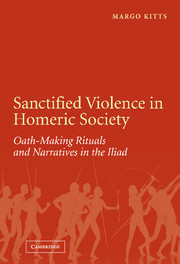Book contents
- Frontmatter
- Contents
- Acknowledgments
- Introduction: Why Another Treatment of Greek Sacrifice?
- 1 Epics, Rituals, and Rituals in Epic: Some Methodological Considerations
- 2 Premises and Principles of Oath-Making in the Iliad
- 3 Ritual Scenes and Epic Themes of Oath-Sacrifice
- 4 Homeric Battlefield Theophanies, in the Light of the Ancient Near East
- Conclusion
- Appendix: Homeric Texts for the Principal Oaths Discussed
- Bibliography
- Index
3 - Ritual Scenes and Epic Themes of Oath-Sacrifice
Published online by Cambridge University Press: 21 February 2011
- Frontmatter
- Contents
- Acknowledgments
- Introduction: Why Another Treatment of Greek Sacrifice?
- 1 Epics, Rituals, and Rituals in Epic: Some Methodological Considerations
- 2 Premises and Principles of Oath-Making in the Iliad
- 3 Ritual Scenes and Epic Themes of Oath-Sacrifice
- 4 Homeric Battlefield Theophanies, in the Light of the Ancient Near East
- Conclusion
- Appendix: Homeric Texts for the Principal Oaths Discussed
- Bibliography
- Index
Summary
The theories outlined in chapter 1 and the cultural principles and premises described in Chapter 2 provide us with lenses through which we now can examine the Iliad's two complete oath sacrifices of Books 3 and 19. In the first part of this chapter, we shall examine each element of the oath-sacrificing ritual scene, as well as the cohesion of its elements into a liturgical order, as defined in Chapter 1. As part of this examination, we shall weigh each element in the oath-sacrificing scene against other instances of that same element as displayed in other ritual events in the Iliad, and also against a handful of conspicuously similar events referred to in Near Eastern texts. To explore the cohesion of the ritual's various elements we shall attempt to trace the intertextual tensions between the apparent performance pattern of the ritual and the typical poetic scene of oath-sacrifice, relying on theories introduced in Chapter 1.
The second part of this chapter has a more elusive aim, which is to gauge the extent to which a resonance between ritual slaughter and battlefield slaughter, if any, could have been intuited by ancient audiences to the Iliad. To establish that there was such a resonance, we first shall explore some shared lexical features between the oath-sacrificing ritual scene and certain killing and dying scenes, to illuminate some common narrative shapes and themes.
- Type
- Chapter
- Information
- Sanctified Violence in Homeric SocietyOath-Making Rituals in the Iliad, pp. 115 - 187Publisher: Cambridge University PressPrint publication year: 2005

